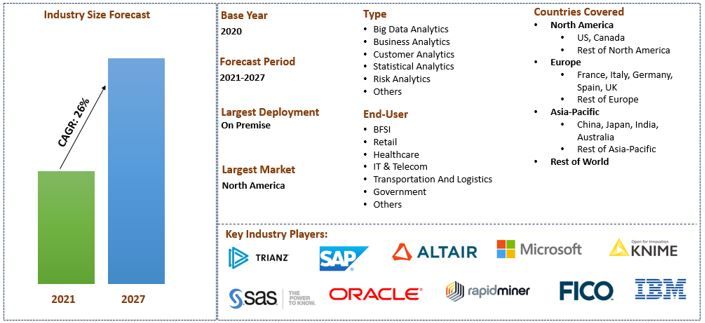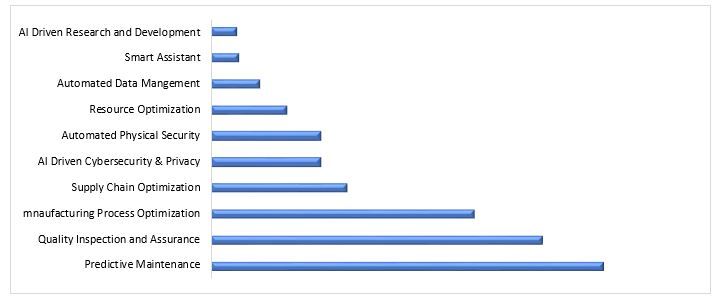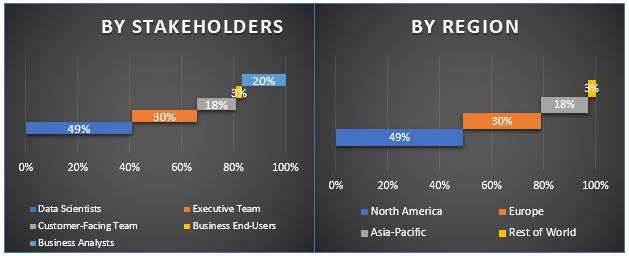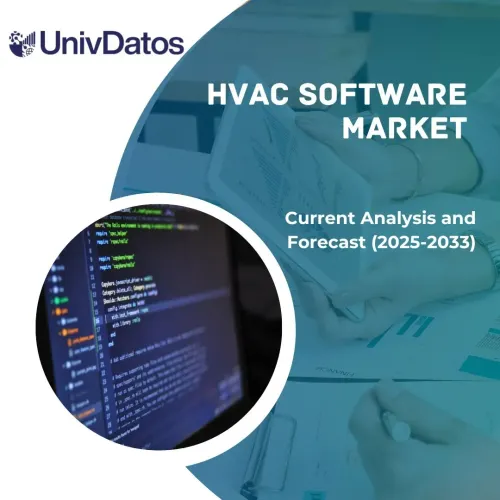- Strona główna
- O nas
- Branża
- Usługi
- Czytanie
- Kontakt
Rynek zaawansowanej analityki: aktualna analiza i prognoza (2021-2027)
Nacisk na typ (analiza dużych zbiorów danych, analiza biznesowa, analiza klientów, analiza statystyczna, analiza ryzyka, inne); Wdrożenie (lokalne, chmura); Wielkość przedsiębiorstwa (małe i średnie, duże); Użytkownik końcowy (BFSI, handel detaliczny, ochrona zdrowia, IT i telekomunikacja, transport i logistyka, administracja publiczna, inne); oraz region i kraj.
 Oczekuje się, że rynek zaawansowanej analityki przekroczy wartość rynkową ponad US$ XX miliardów w 2027 roku i będzie rósł w znaczącym tempie CAGR wynoszącym 26% w okresie prognozowania (2021-2027). Zaawansowana analityka to półautonomiczne i autonomiczne badanie danych za pomocą zaawansowanych narzędzi i technik, których zazwyczaj nie można wykonać za pomocą tradycyjnej analizy biznesowej (BI), a które pomagają odkrywać głębsze spostrzeżenia, generować rekomendacje lub dokonywać prognoz. Zaawansowana analityka obejmuje techniki takie jak uczenie maszynowe, prognozowanie, eksploracja danych/tekstu, dopasowywanie wzorców, wizualizacja, analiza semantyczna, analiza sieci i skupień, analiza sentymentu, symulacja, sieci neuronowe, przetwarzanie zdarzeń itp. Jest to stale rozwijające się i rosnące wraz z nowymi dodatkami w branży. Analityka danych zasadniczo pomaga w lepszym wykorzystaniu danych. Organizacje mogą wykonywać zaawansowane modele statystyczne za pomocą zaawansowanych narzędzi analitycznych. Te obliczenia „co by było, gdyby” z zaawansowaną analityką pomagają zabezpieczyć różne aspekty operacyjne firmy na przyszłość.
Oczekuje się, że rynek zaawansowanej analityki przekroczy wartość rynkową ponad US$ XX miliardów w 2027 roku i będzie rósł w znaczącym tempie CAGR wynoszącym 26% w okresie prognozowania (2021-2027). Zaawansowana analityka to półautonomiczne i autonomiczne badanie danych za pomocą zaawansowanych narzędzi i technik, których zazwyczaj nie można wykonać za pomocą tradycyjnej analizy biznesowej (BI), a które pomagają odkrywać głębsze spostrzeżenia, generować rekomendacje lub dokonywać prognoz. Zaawansowana analityka obejmuje techniki takie jak uczenie maszynowe, prognozowanie, eksploracja danych/tekstu, dopasowywanie wzorców, wizualizacja, analiza semantyczna, analiza sieci i skupień, analiza sentymentu, symulacja, sieci neuronowe, przetwarzanie zdarzeń itp. Jest to stale rozwijające się i rosnące wraz z nowymi dodatkami w branży. Analityka danych zasadniczo pomaga w lepszym wykorzystaniu danych. Organizacje mogą wykonywać zaawansowane modele statystyczne za pomocą zaawansowanych narzędzi analitycznych. Te obliczenia „co by było, gdyby” z zaawansowaną analityką pomagają zabezpieczyć różne aspekty operacyjne firmy na przyszłość.
Ogromnie rosnąca ilość danych przemysłowych przyspiesza rozwój rynku zaawansowanej analityki. Dodatkowo, na przyjęcie tej technologii wpłynęła również pandemia Covid-19, ponieważ przedsiębiorstwa walczyły o przetrwanie. Zaawansowana analityka dała im nadzieję na przyjęcie zalecanych zmian w celu zwiększenia wzrostu ich działalności. Najnowsze postępy w uczeniu maszynowym, analizie semantycznej, eksploracji danych, technologii sieci neuronowych i wielu innych również napędzają wzrost rynku zaawansowanej analityki. Wraz ze wzrostem ilości danych generowanych przez przedsiębiorstwa, takie jak BFSI, IT, energetyka i media itp., przetwarzanie danych i szybkie podejmowanie decyzji są niezbędne, aby utrzymać przewagę konkurencyjną. Zwiększa to zależność przemysłu od sektora zaawansowanej analityki, który szacuje się, że wykaże znaczny wzrost rynku w prognozowanym okresie. Według raportu AIM i praxis business school of India, w 2018 roku branża data science i analityki oraz big data osiągnęła roczny przychód w wysokości 2,71 miliarda USD i wzrosła do 3,03 miliarda USD w 2019 roku, a liczba ta ma się podwoić do 2025 roku.
Wykorzystanie sztucznej inteligencji w różnych branżach na świecie (%), IV kwartał 2021 r.

Altair Engineering, Inc., Fair Isaac Corporation, International Business Machines Corp., KNIME, Microsoft Corporation, Oracle Corporation, RapidMiner, Inc., SAP SE, SAS Institute Inc. i Trianz to jedni z czołowych graczy działających na rynku Advanced Analytics. Gracze ci podjęli szereg fuzji i przejęć wraz z partnerstwami, aby ułatwić klientom dostęp do zaawansowanych technologicznie i innowacyjnych produktów/technologii.
Wnioski przedstawione w raporcie
„Wśród typów, segment Big Data Analytics ma największy udział”
Na podstawie typu rynek zaawansowanej analityki jest podzielony na Big Data Analytics, Business Analytics, Customer Analytics, Statistical Analytics, Risk Analytics i inne. Wśród typów, segment analizy dużych zbiorów danych (big data analytics) na rynku zaawansowanej analityki został wyceniony na US$ XX miliardów w 2020 roku i prawdopodobnie osiągnie US$ XX miliardów do 2027 roku, rosnąc w tempie CAGR wynoszącym XX% w latach 2021-2027. Wynika to z rosnącej popularności mediów społecznościowych oraz platform wirtualnych i cyfrowych. Platformy te generują dużą ilość danych, którymi należy zarządzać, co jest rozwijającym się obszarem w analizie dużych zbiorów danych. Rosnące zastosowanie analizy dużych zbiorów danych zwiększa efektywność i strategie marketingowe firm. Oczekuje się, że kolejnym segmentem, który będzie rósł w znaczącym tempie w okresie prognozowania, jest segment analizy klientów ze względu na rosnące zapotrzebowanie na zarządzanie leadami, zarządzanie doświadczeniami klientów i techniki utrzymywania klientów.
„Wśród wdrożeń, segment On-Premise ma największy udział”
Na podstawie wdrożenia rynek zaawansowanej analityki jest podzielony na On-Premise i Cloud. Wśród wdrożeń segment on-premise stanowił wartość rynkową w wysokości US$ XX miliardów w 2020 roku i oczekuje się, że osiągnie US$ XX miliardów do roku 2027, przy CAGR wynoszącym XX% w analizowanym okresie. Organizacje z wdrożeniem on-premise mogą zachować większą elastyczność i dostosowywać swoją infrastrukturę IT. Zmniejsza to również zależność organizacji od infrastruktury internetowej i może chronić ich dane przed oszustwami i potencjalnymi stratami. Korzyści te zachęcają coraz więcej organizacji (zwłaszcza dużych) do wyboru wdrożenia on-premise.
„Wśród wielkości przedsiębiorstw, segment Large Enterprise ma największy udział”
Na podstawie wielkości przedsiębiorstwa rynek zaawansowanej analityki jest podzielony na małe i średnie oraz duże. Segment dużych przedsiębiorstw wygenerował przychody w wysokości US$ XX miliardów w 2020 roku i oczekuje się, że będzie rósł w tempie CAGR wynoszącym XX% w okresie prognozowania, osiągając wartość rynkową US$ XX miliardów do 2027 roku. Wynika to z przyjęcia rozwiązań analitycznych w różnych zastosowaniach, w tym analizy biznesowej i klientów, co może pomóc w efektywnym zarządzaniu dużymi bazami danych. Ponieważ duże organizacje również generują duże ilości danych, ich adaptacja napędza wzrost rynku zaawansowanej analityki. Duże przedsiębiorstwa wdrażają planowanie zasobów przedsiębiorstwa, zarządzanie danymi i analizę lokalizacji, co napędza wzrost segmentu.
„Wśród użytkowników końcowych, segment BSFI ma największy udział”
Na podstawie użytkownika końcowego rynek zaawansowanej analityki jest podzielony na BFSI, handel detaliczny, opiekę zdrowotną, IT i telekomunikację, transport i logistykę, rząd i inne. Wśród użytkowników końcowych, segment BSFI na rynku zaawansowanej analityki został wyceniony na US$ XX miliardów w 2020 roku i prawdopodobnie osiągnie US$ XX miliardów do 2027 roku, rosnąc w tempie CAGR wynoszącym XX% w latach 2021-2027. BFSI przyjęło zaawansowaną analitykę w celu identyfikacji oszukańczych transakcji, ryzyka związanego z obsługą danych i optymalizacji procesów. Z pomocą analityki banki i inne instytucje finansowe mogą przetwarzać dane nieustrukturyzowane i zapewniać zgodność z przepisami. Ponadto pozwala to instytucjom finansowym na przyjęcie lepszej efektywności operacyjnej i poprawę doświadczenia klienta. Oczekuje się, że rosnący popyt na zastąpienie narzędzi technologicznych zapobiegających oszustwom zaawansowaną analityką pobudzi segment BFSI na rynku zaawansowanej analityki.
„Ameryka Północna reprezentuje jeden z największych rynków Advanced Analytics”
Dla lepszego zrozumienia dynamiki rynku Advanced Analytics przeprowadzono szczegółową analizę dla różnych regionów na całym świecie, w tym Ameryki Północnej (USA, Kanada i reszta Ameryki Północnej), Europy (Niemcy, Francja, Włochy, Wielka Brytania, Hiszpania i reszta Europy), Azji i Pacyfiku (Chiny, Japonia, Indie, Australia i reszta APAC) oraz reszty świata. Ameryka Północna zdominowała rynek i zajęła około XX% udziału w rynku ze względu na rosnące zapotrzebowanie na zarządzanie danymi przez przemysł.
Powody, dla których warto kupić ten raport:
- Badanie obejmuje analizę wielkości rynku i prognozowanie, zweryfikowaną przez uwierzytelnionych kluczowych ekspertów branżowych
- Raport przedstawia szybki przegląd ogólnych wyników branży jednocześnie
- Raport obejmuje dogłębną analizę wybitnych podmiotów z branży, z głównym naciskiem na kluczowe dane finansowe, portfolio produktów, strategie ekspansji i najnowsze wydarzenia
- Szczegółowe badanie czynników napędzających, ograniczeń, kluczowych trendów i możliwości występujących w branży
- Badanie kompleksowo obejmuje rynek w różnych segmentach
- Dogłębna analiza branży na poziomie regionalnym
Opcje dostosowywania:
Rynek zaawansowanej analityki można dodatkowo dostosować zgodnie z wymaganiami lub dowolnym innym segmentem rynku. Poza tym UMI rozumie, że możesz mieć własne potrzeby biznesowe, dlatego zachęcamy do kontaktu z nami, aby otrzymać raport, który w pełni odpowiada Twoim wymaganiom.
Spis treści
Analiza historycznego rynku, szacowanie obecnego rynku i prognozowanie przyszłego rynku zaawansowanej analityki to trzy główne kroki podjęte w celu stworzenia i analizy adopcji zaawansowanej analityki w głównych regionach na świecie. Przeprowadzono wyczerpujące badania wtórne w celu zebrania historycznych danych rynkowych i oszacowania obecnej wielkości rynku. Po drugie, aby zweryfikować te spostrzeżenia, wzięto pod uwagę liczne ustalenia i założenia. Ponadto przeprowadzono wyczerpujące wywiady pierwotne z ekspertami branżowymi w całym łańcuchu wartości rynku zaawansowanej analityki. Po założeniu i zatwierdzeniu danych rynkowych za pomocą wywiadów pierwotnych, zastosowaliśmy podejście odgórne/oddolne do prognozowania całkowitej wielkości rynku. Następnie przyjęto metody podziału rynku i triangulacji danych w celu oszacowania i analizy wielkości rynku segmentów i podsegmentów, których dotyczy branża. Szczegółowa metodologia została wyjaśniona poniżej:
Analiza historycznej wielkości rynku
Krok 1: Dogłębne badanie źródeł wtórnych:
Przeprowadzono szczegółowe badanie wtórne w celu uzyskania historycznej wielkości rynku zaawansowanej analityki za pośrednictwem wewnętrznych źródeł firmy, takich jak raport roczny i sprawozdania finansowe, prezentacje wyników, komunikaty prasowe itp., oraz źródeł zewnętrznych, w tym czasopisma, wiadomości i artykuły, publikacje rządowe, publikacje konkurencji, raporty sektorowe, bazy danych stron trzecich i inne wiarygodne publikacje.
Krok 2: Segmentacja rynku:
Po uzyskaniu historycznej wielkości rynku zaawansowanej analityki, przeprowadziliśmy szczegółową analizę wtórną w celu zebrania historycznych informacji o rynku i udziału dla różnych segmentów i podsegmentów dla głównych regionów. Główne segmenty zawarte w raporcie to typ, wdrożenie, wielkość przedsiębiorstwa i użytkownik końcowy. Przeprowadzono dalsze analizy na poziomie krajowym w celu oceny ogólnej adopcji zaawansowanej analityki w danym regionie.
Krok 3: Analiza czynnikowa:
Po uzyskaniu historycznej wielkości rynku dla różnych segmentów i podsegmentów, przeprowadziliśmy szczegółową analizę czynnikową w celu oszacowania obecnej wielkości rynku zaawansowanej analityki. Ponadto przeprowadziliśmy analizę czynnikową przy użyciu zmiennych zależnych i niezależnych, takich jak wzrost ilości danych i rosnąca potrzeba ich zarządzania w przedsiębiorstwach. Przeprowadzono dokładną analizę scenariuszy popytowych i podażowych, biorąc pod uwagę najważniejsze partnerstwa, fuzje i przejęcia, ekspansję biznesową i wprowadzenie produktów na rynek w sektorze zaawansowanej analityki na całym świecie.
Szacowanie obecnej wielkości rynku i prognoza
Określanie obecnej wielkości rynku: W oparciu o praktyczne wnioski z powyższych 3 kroków, doszliśmy do obecnej wielkości rynku, kluczowych graczy na rynku zaawansowanej analityki i udziałów rynkowych segmentów. Wszystkie wymagane udziały procentowe i podziały rynku zostały określone przy użyciu wspomnianego powyżej podejścia wtórnego i zostały zweryfikowane poprzez wywiady pierwotne.
Szacowanie i prognozowanie: Do oszacowania rynku i prognozy przypisano wagi różnym czynnikom, w tym czynnikom napędzającym i trendom, ograniczeniom i możliwościom dostępnym dla interesariuszy. Po przeanalizowaniu tych czynników zastosowano odpowiednie techniki prognozowania, tj. podejście odgórne/oddolne, aby dojść do prognozy rynkowej około 2027 r. dla różnych segmentów i podsegmentów na głównych rynkach na całym świecie. Metodologia badawcza przyjęta do oszacowania wielkości rynku obejmuje:
- Wielkość rynku branży pod względem wartości (USD) i wskaźnik adopcji zaawansowanej analityki na głównych rynkach krajowych
- Wszystkie udziały procentowe, podziały i rozbicia segmentów i podsegmentów rynku
- Kluczowi gracze na rynku zaawansowanej analityki pod względem oferowanych produktów. Również strategie wzrostu przyjęte przez tych graczy, aby konkurować na szybko rozwijającym się rynku
Walidacja wielkości i udziału w rynku
Badania pierwotne: Przeprowadzono dogłębne wywiady z kluczowymi liderami opinii (Key Opinion Leaders - KOLs), w tym z kadrą kierowniczą najwyższego szczebla (CXO/VP, kierownicy sprzedaży, kierownicy marketingu, kierownicy operacyjni i kierownicy regionalni, kierownicy krajowi itp.) w głównych regionach. Następnie podsumowano wyniki badań pierwotnych i przeprowadzono analizę statystyczną w celu udowodnienia postawionej hipotezy. Dane wejściowe z badań pierwotnych zostały połączone z wynikami wtórnymi, przekształcając w ten sposób informacje w przydatne spostrzeżenia.
Podział uczestników badań pierwotnych w różnych regionach

Inżynieria rynku
Zastosowano technikę triangulacji danych, aby ukończyć ogólne oszacowanie rynku i dojść do precyzyjnych danych statystycznych dla każdego segmentu i podsegmentu rynku zaawansowanej analityki. Dane zostały podzielone na kilka segmentów i podsegmentów po przestudiowaniu różnych parametrów i trendów w obszarach typu i ich typu rynku zaawansowanej analityki.
Główny cel badania rynku zaawansowanej analityki
W badaniu wskazano obecne i przyszłe trendy rynkowe zaawansowanej analityki. Inwestorzy mogą uzyskać strategiczne informacje, na których mogą opierać swoje decyzje inwestycyjne, z analizy jakościowej i ilościowej przeprowadzonej w badaniu. Obecne i przyszłe trendy rynkowe określały ogólną atrakcyjność rynku na poziomie regionalnym, zapewniając uczestnikowi przemysłowemu platformę do wykorzystania niewykorzystanego rynku, aby czerpać korzyści jako pionier. Inne ilościowe cele badań obejmują:
- Analiza obecnej i prognozowanej wielkości rynku zaawansowanej analityki pod względem wartości (USD). Ponadto analiza obecnej i prognozowanej wielkości rynku dla różnych segmentów i podsegmentów
- Segmenty w badaniu obejmują obszary typu i ich podtypy
- Definiowanie i analiza ram regulacyjnych dla branży zaawansowanej analityki
- Analiza łańcucha wartości związanego z obecnością różnych pośredników, wraz z analizą zachowań klientów i konkurentów w branży
- Analiza obecnej i prognozowanej wielkości rynku zaawansowanej analityki dla głównego regionu
- Główne regiony badane w raporcie obejmują Amerykę Północną (USA, Kanada i reszta Ameryki Północnej), Europę (Niemcy, Wielka Brytania, Francja, Hiszpania, Włochy i reszta Europy), Azję i Pacyfik (Chiny, Japonia, Indie, Australia i inne) oraz resztę świata
- Profile firm na rynku zaawansowanej analityki oraz strategie wzrostu przyjęte przez uczestników rynku w celu utrzymania się na szybko rozwijającym się rynku
- Dogłębna analiza branży na poziomie regionalnym
Powiązane Raporty
Klienci, którzy kupili ten przedmiot, kupili również










